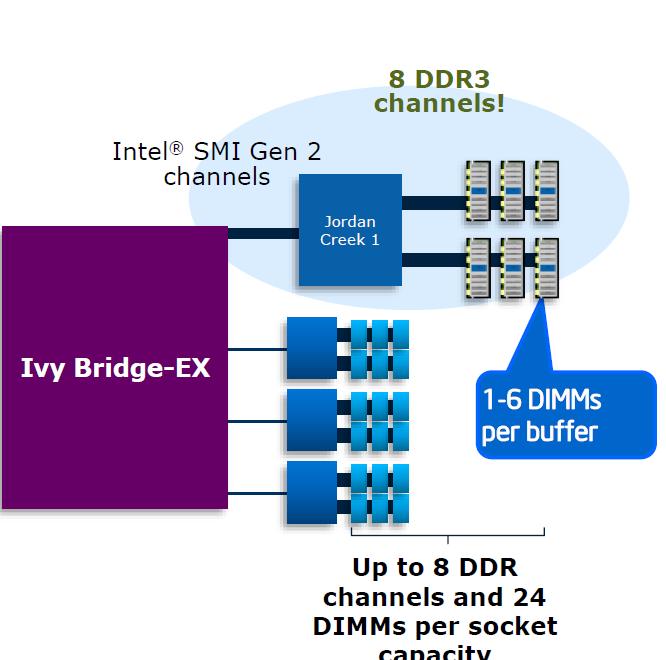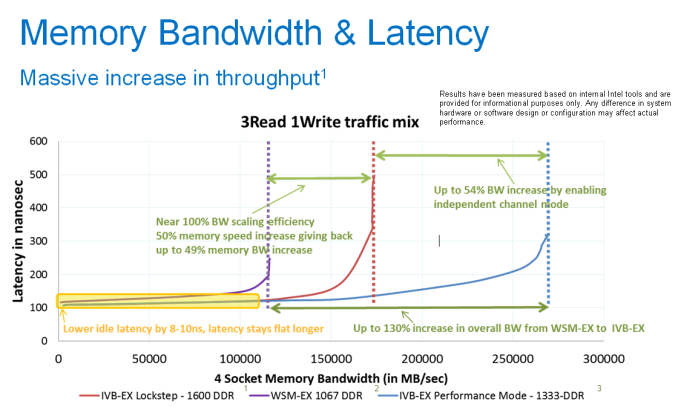The Intel Xeon E7 v2 Review: Quad Socket, Up to 60 Cores/120 Threads
by Johan De Gelas on February 21, 2014 6:00 AM EST- Posted in
- IT Computing
- Intel
- Xeon
- Ivy Bridge EX
- server
- Brickland
Bandwidth Monster
Previous versions of Intel's flagship Xeon always came with very conservative memory configurations as RAM capacity and reliability was the priority. Typically, these systems came with memory extension buffers for increased capacity, but those memory buffers also increase memory latency. As a result, these quad- and octal-socket monsters had a hard time competing with the best dual-Xeon setups in memory intensive applications.
The new Xeon E7 v2 still has plenty of memory buffers (code named "Jordan Creek"), and it now supports three instead of two DIMMs per channel. The memory riser cards with two buffers now support 12 instead of eight DIMMs (Xeon Westmere-EX). Using relatively affordable 32GB DIMMs, this allows you to load a system machine up to 3TB RAM. If you break the bank and use 64GB LRDIMMs, 6TB RAM is possible.
With the previous platform, having eight memory channels only increased capacity and not bandwidth as they ran in lockstep. Each channel delivers half a cache line, then the Jordan Creek buffer combines those halves and sends off the result to the requesting memory controller. The high speed serial interface or scalable memory interconnect (SMI) channels must run at the same speed as the DDR3 channels. With Westmere-EX, this resulted in an SMI running at a maximum of 1066MHz. With the Xeon E7 v2, we get four SMI interconnects running at speeds up to 1600MHz. In lockstep, the system can survive a dual-device error. As result, the RAS (Reliability, Accessibility, Serviceability) is best in Lockstep.
With the Ivy Bridge EX version of the Xeon E7, the channels can also run independently. This mode is called performance mode and each channel can deliver one cache line. To cope with twice the amount of bandwidth, the SMI interconnect must run twice as fast as the memory channels. In this case, the SMI channel can run at 2667 MT/s while the two channels work at 1333 MT/s. That means in theory, the E7 v2 chip could deliver as much as 85GB/s (1333 * 8 channels * 8 bytes per channel) of bandwidth, which is 2.5x more than what the previous platform delivered. The disadvantage is that only a single device error can be corrected—more speed, less RAS.
According to Intel, both latency and bandwidth are improved tremendously compared to the Westmere-EX platform. As a result, the new quad Xeon E7 v2 platform should perform a lot better in memory intensive HPC applications.












125 Comments
View All Comments
snoopy1710 - Friday, February 21, 2014 - link
Minor correction on the Dell E7-4890 SAP benchmark, which was done on SUSE Linux Enterprise Server for SAP Applications:http://download.sap.com/download.epd?context=40E2D...
Snoopy
FunBunny2 - Friday, February 21, 2014 - link
you should opt for ubuntu 12.04. "real" databases are approved only for LTS versions, and 12.04 is the latest.bji - Friday, February 21, 2014 - link
Page 10 does not contain the Linux Kernel Compile time benchmarks.JohanAnandtech - Saturday, February 22, 2014 - link
The web engine did something weird...I restored the pageJawsOfLife - Friday, February 21, 2014 - link
Very thorough review, which is what I've come to expect from Anandtech! I am interested but not very knowledgeable about the server side of computing, so this definitely filled me in on a lot of the facets of that area. Thanks for the writeup.By the way, the "Linux Kernel Compile" page is blank, as bji noted.
JohanAnandtech - Saturday, February 22, 2014 - link
Thx. A glitch in the engine made it delete a page. Restored.iwod - Friday, February 21, 2014 - link
While the revenue are high, just how many unit are shipped?I have been thinking if Intel would move Mobile First, meaning Atom, Tablet and Laptop Chips all gets the latest node first, which are low power design. While Desktop and Server will be a Architecture and Node behind. Which will align the Desktop and Xeon E3 - E5 Series.
But it seems the volume of Chips dont quite measure out, since the top end volume are far too small? Anyone have any idea on this.
dealcorn - Saturday, February 22, 2014 - link
I believe the statement "Still, that tiny amount of RISC servers represents about 50% of the server market revenues." should read "Still, that tiny amount of RISC servers represents about 50% of the high end server market revenues." Stated differently, from a revenue perspective Intel is #1 vendor in the high end segment even though it has less than a 50% market share. Server orders are placed with vendors, not architectures. Intel has fought an uphill battle to access the high end market and it is costly. However, if Intel can amortize its development costs over a larger revenue base than any competitor, it is well positioned to maintain it's share acquisition momentum.NikosD - Saturday, February 22, 2014 - link
@JohanVery nice review, I would like to see more benchmarks between E7 v2 vs RISC processors because I think the real competition is there.
Older Intel and AMD servers are not real competition for IvyBridge-EX.
It would be interesting when POWER8 is out, to give us the new figures of 8 socket benchmarks and if there is any progress on more 8+ sockets for Intel E7 v2 (built by Cray and other vendors)
I think that E7 v2 (I don't know about older vendors) can be placed in up to 32-socket systems - not natively of course.
JohanAnandtech - Saturday, February 22, 2014 - link
Older Intel systems are competition, because these kind of servers are not replaced quickly. If a new generation does not deliver substantial gains, some companies will postpone replacement. In fact, very few people that already have a quad intel consider the move to RISC platforms.But you have a point. But it is almost impossible for us to do an independent review of other vendors. I have never seen an independent review, and the systems are too scarce, so there is little chance that we can ask a friendly company to borrow us one.